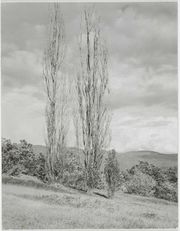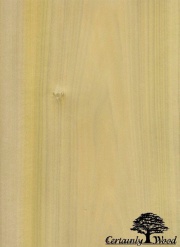Difference between revisions of "Poplar"
| (5 intermediate revisions by the same user not shown) | |||
| Line 3: | Line 3: | ||
== Description == | == Description == | ||
[[File:poplarwc.jpg|thumb|White poplar (''Populus alba'')]] | [[File:poplarwc.jpg|thumb|White poplar (''Populus alba'')]] | ||
| − | Any of several hardwood trees from the genus ''Populus''. The trees are in the willow family and are found in temperate regions of the Northern hemisphere. In general, poplar is a soft, lightweight wood that is easy to work. The wood has a fine, | + | Any of several hardwood trees from the genus ''Populus''. The trees are in the willow (''Salicaceae'') family and are found in temperate regions of the Northern hemisphere. In general, poplar is a soft, lightweight wood that is easy to work. The sapwood is a creamy white and can be variegated or striped. The heartwood tends to have a pale olive color to a pale brown color, and is known to have dark blue, dark purple, dark green and black streaks. The wood is straight grained and has a very fine and even texture. The wood is straight grained with a very fine, even texture. Commercially, poplar is primarily used for paneling, light construction, packing crates, cardboard and paper pulp. |
Common types of poplar trees include: | Common types of poplar trees include: | ||
| Line 24: | Line 24: | ||
peuplier (Fr.), chopo (Esp.); álamo (Esp.); choupo branco (Port.); pioppo (It.) | peuplier (Fr.), chopo (Esp.); álamo (Esp.); choupo branco (Port.); pioppo (It.) | ||
| + | |||
| + | Additional alternate names: Tulip Poplar, American Tulipwood, Tulipwood, American Whitewood, Canary Whitewood, Canary Wood, Canoe Wood, Whitewood, Hickory Poplar, Popple, Saddletree | ||
| + | |||
| + | ==Applications== | ||
| + | * Interior case work | ||
| + | * Molding; trim | ||
| + | * Packing/shipping crates | ||
| + | * Italian panel paintings | ||
| + | * Sculptures of southern Germany in the late Gothic period | ||
| + | |||
| + | ==Personal Risks== | ||
| + | Fine particulates can be a lung irritant. Personal protective equipment (particulate mask and goggles) should be worn. | ||
| + | |||
| + | ==Collection Risks== | ||
| + | VOC emissions from well-aged hardwoods are less than softwoods but there is still acetaldehyde (acetic acid) and formaldehyde (formic acid). Acids can be a problem for corrosion of metal objects and cause deterioration of carbonate-based materials such as shells and marbles. | ||
| + | |||
| + | The presence of acidic acid and the oxidation of formaldehyde (creating formic acid) puts many collections at risk. Lead, zinc and copper alloys and other metals are vulnerable to corrosion. Paper, textiles, and proteins are in danger of fading and embrittlement. Calcareous materials and mineral specimens are at risk of corrosion and formation of salts. | ||
| + | It is not naturally insect repellent so there can be a risk pests. | ||
| + | |||
| + | Failed Oddy test | ||
== Physical and Chemical Properties == | == Physical and Chemical Properties == | ||
| Line 68: | Line 88: | ||
| − | + | [[Category:Materials database]][[Category:MWG]][[Category: Wood]] | |
| − | [[Category:Materials database]] | ||
Latest revision as of 11:33, 26 October 2020
Description
Any of several hardwood trees from the genus Populus. The trees are in the willow (Salicaceae) family and are found in temperate regions of the Northern hemisphere. In general, poplar is a soft, lightweight wood that is easy to work. The sapwood is a creamy white and can be variegated or striped. The heartwood tends to have a pale olive color to a pale brown color, and is known to have dark blue, dark purple, dark green and black streaks. The wood is straight grained and has a very fine and even texture. The wood is straight grained with a very fine, even texture. Commercially, poplar is primarily used for paneling, light construction, packing crates, cardboard and paper pulp.
Common types of poplar trees include:
1) Balsam poplar (Populus balsamifer or Populus tac a ma haca)
2) Cottonwood (Populus deltoides)
3) English poplar or black poplar (Populus nigra)
4) Gray poplar (Populus x canescens)
5) White poplar (Populus alba)
6) Trembling poplar or Aspen (Populus tremula)
7) Yellow poplar or Tulip tree (Liriodendron tulipifera)
Synonyms and Related Terms
peuplier (Fr.), chopo (Esp.); álamo (Esp.); choupo branco (Port.); pioppo (It.)
Additional alternate names: Tulip Poplar, American Tulipwood, Tulipwood, American Whitewood, Canary Whitewood, Canary Wood, Canoe Wood, Whitewood, Hickory Poplar, Popple, Saddletree
Applications
- Interior case work
- Molding; trim
- Packing/shipping crates
- Italian panel paintings
- Sculptures of southern Germany in the late Gothic period
Personal Risks
Fine particulates can be a lung irritant. Personal protective equipment (particulate mask and goggles) should be worn.
Collection Risks
VOC emissions from well-aged hardwoods are less than softwoods but there is still acetaldehyde (acetic acid) and formaldehyde (formic acid). Acids can be a problem for corrosion of metal objects and cause deterioration of carbonate-based materials such as shells and marbles.
The presence of acidic acid and the oxidation of formaldehyde (creating formic acid) puts many collections at risk. Lead, zinc and copper alloys and other metals are vulnerable to corrosion. Paper, textiles, and proteins are in danger of fading and embrittlement. Calcareous materials and mineral specimens are at risk of corrosion and formation of salts. It is not naturally insect repellent so there can be a risk pests.
Failed Oddy test
Physical and Chemical Properties
- Diverse trees from from 15-50 m tall and tend to be slender
- Bark: smooth and white to greenish or gray
- Flower are long, drooping catkins
- Annual rings = well-defined
- Rays = fine
- Density = 22-35 ppcf
- Anisotropic
- Responds to humidity and can act as buffer
- Medium density wood with low-bending, shock resistance, stiffness and compression values
Working Properties
Poplar is one of the softest hardwoods available. It is very easily worked and machined. Poplar is suitable for turnings. Poplar is also suitable for boring and takes mortising well. Yellow Poplar is not suitable for moulding production but is suitable for carving. Poplar takes glue well. Mechanical fasteners all work fairly well, however screws and staples hold much better than nails. Because of its softness and character sanding and finishing poplar can take more effort than other wood species. Finish application can raise the grain requiring additional coats of primer or finish with sanding required between coats. If heartwood is present in the stock it can leach color into water-based finishes resulting in uneven finish color. This heartwood is not structurally inferior. Poplar takes stain and varnish well. Poplar is suitable for steam bending.
Forms and Sizes
Comes in typical lumber dimensions and can be cut down to any size
Resources and Citations
- Alden Identification Services, Microscopic Wood Identification: Link
- Schoch, W., Heller, I., Schweingruber, F.H., Kienast, F., 2004:Wood anatomy of central European Species: White Poplar, Populus alba L.
- RexLumber: Link DC hardwood supplier that has extensive hardwood operations on East Coast
- American Hardwood Information Center: Link
- R. J. Gettens, G.L. Stout, Painting Materials, A Short Encyclopaedia, Dover Publications, New York, 1966
- G.S.Brady, Materials Handbook, McGraw-Hill Book Co., New York, 1971 Comment: p. 629
- Hermann Kuhn, Conservation and Restoration of Works of Art and Antiquities, Butterworths, London, 1986
- F. H. Titmuss, Commercial Timbers of the World, The Technical Press Ltd., London, 1965 Comment: 25-35 ppcf
- Dictionary of Building Preservation, Ward Bucher, ed., John Wiley & Sons, Inc., New York City, 1996
- Pam Hatchfield, Pollutants in the Museum Environment, Archetype Press, London, 2002
- Encyclopedia Britannica, http://www.britannica.com Comment: "poplar" [Accessed November 7, 2001].
- CRC Handbook of Chemistry and Physics, Robert Weast (ed.), CRC Press, Boca Raton, Florida, v. 61, 1980 Comment: density=22-31 ppcf (0.35-0.50 g/cm3)


